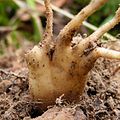Dactylorhiza maculata
| Dactylorhiza maculata | |
|---|---|

| |
| Dactylorhiza maculata subsp. maculata | |
| Scientific classification | |
| Kingdom: | Plantae |
| Clade: | Tracheophytes |
| Clade: | Angiosperms |
| Clade: | Monocots |
| Order: | Asparagales |
| Family: | Orchidaceae |
| Subfamily: | Orchidoideae |
| Genus: | Dactylorhiza |
| Species: | D. maculata
|
| Binomial name | |
| Dactylorhiza maculata | |
| Synonyms[1] | |
| |
Dactylorhiza maculata, known as the heath spotted-orchid[2] or moorland spotted orchid, is an herbaceous perennial plant of the family Orchidaceae. It is widespread in mountainous regions across much of Europe from Portugal and Iceland east to Russia. It is also found in Algeria, Morocco, and western Siberia.[1][3]
Etymology
[edit]The name of the genus Dactylorhiza is formed from the Greek words δάκτυλος 'daktylos' meaning 'finger' and ρίζα 'ridza' meaning 'root' and refers to the tubers of this plant, which are split into several tubercles. The specific epithet 'maculata', meaning 'spotted', refers to the stained leaves. The scientific binomial name of this plant was initially Orchis maculata, proposed by the Swedish naturalist and botanist Carl Linnaeus in 1753. The name was changed to the one currently accepted (Dactylorhiza maculata) by the Hungarian botanist Károly Rezső Soó in 1962. In German this plant is called Geflecktes Knabenkraut, in French orchis tacheté, and in Italian orchide macchiata or erba d'Adamo.
Description
[edit]
Dactylorhiza maculata are usually 15–45 centimetres (5.9–17.7 in) in height, with a maximum of 70 centimetres (28 in). These plants are bulbous geophytes, forming their buds in underground tubers or bulbs, organs that annually produce new stems, leaves and flowers. Furthermore these orchids are terrestrial: unlike epiphytes they do not live on other large plants.
This orchid has an erect, glabrous and cylindrical stem, with a streaked surface. The leaves are oblong or oval-lanceolate, with dark ellipsoid-shaped spots on the surface (hence the species name). The leaves are amplexicaul and can be either radical (basal) or cauline.
The underground part of the stem has two webbed tubers, each deeply divided into several lobes or tubercles (characteristic of the genus Dactylorhiza). The first one has the important function of supplying the stem whilst the second collects nutrients for the development of the plant that will form in the coming year.[citation needed]
The inflorescence is 5–15 centimetres (2.0–5.9 in) long and it is composed of flowers gathered in dense spikes. The flowers grow in the axils of bracts membranous and lanceolate-shaped. Their colours vary from light pink to purple or white with darker streaks mainly on the labellum (sometimes at the margins of tepals). The flowers reach on average 10–15 centimetres (3.9–5.9 in). The flowers are hermaphrodite and insect pollinated.
Habitat
[edit]The heath spotted orchid prefers sunny places on lowlands or hills. It can be found in slightly damp meadows but also in the undergrowth of dry forests, in areas with bushes and at the edges of streams. It grows on siliceous and calcareous substrate, at elevations up to 2,200 metres (7,200 ft) above sea level.
Ecology
[edit]Orchids in the genus Dactylorhiza are mycorrhizal generalists. D. maculata has been found to form associations with a range of common species of mycorrhizal fungi in the Tulasnellaceae, as well as with species in the Ceratobasidiaceae and Sebacinales.[4][5]
Dactylorhiza maculata is pollinated by insects, especially bumblebees. The flowers are 'food deceptive', i.e. do not provide nectar for their pollinators.[6]
Subspecies
[edit]Many names have been proposed for species and varieties in the species. As of September 2024, the following subspecies are accepted:[7]
- Dactylorhiza maculata subsp. fuchsii (Druce) Hyl. – Europe to Siberia and Mongolia
- Dactylorhiza maculata subsp. maculata (L.) Soó – Europe to Siberia
- Dactylorhiza maculata subsp. maurusia (Emb. & Maire) Soó – Morocco and northern Algeria
- Dactylorhiza maculata subsp. saccifera (Brongn.) Diklic – southern Europe and Turkey
- Dactylorhiza maculata subsp. sooana Borsos ex Batoušek – Slovakia
- Dactylorhiza maculata nothosubsp. transiens (Druce) M.H.J.van der Meer (D. maculata subsp. fuchsii × D. maculata subsp. maculata) – Germany, France, Spain, Great Britain, and Ireland
Inter-species hybrids
[edit]Inter-species hybrids include:
- Dactylorhiza × kerneriorum nothosubsp. kerneriorum (syn. Dactylorhiza × ruthei (M.Schulze ex Ruthe) Soó) (D. incarnata subsp. incarnata × D. maculata subsp. fuchsii) – Spain, France, Great Britain and Ireland, middle Europe, Romania, and East European Russia)[8]
Gallery
[edit]-
Flowers
-
Close-up on inflorescence
-
Inflorescence
-
Inflorescence
-
Fruits
-
The tubers are split into several tubercles, hence the name Dactylorhiza
-
The stained leaf, hence the name "maculata" meaning =spotted
References
[edit]- ^ a b Kew World Checklist of Selected Plant Families
- ^ BSBI List 2007 (xls). Botanical Society of Britain and Ireland. Archived from the original (xls) on 2015-06-26. Retrieved 2014-10-17.
- ^ Altervista Flora Italiana, Orchide macchiata, Dactylorhiza maculata (L.) Soó includes European distribution map
- ^ Jacquemyn, H.; Deja, A.; De Hert, K.; Cachapa Bailarote, B.; Lievens, B. (2012). "Variation in Mycorrhizal Associations with Tulasnelloid Fungi among Populations of Five Dactylorhiza Species". PLOS ONE. 7 (8): e42212. Bibcode:2012PLoSO...742212J. doi:10.1371/journal.pone.0042212. PMC 3411701. PMID 22870305.
- ^ Jacquemyn, H.; Waud, M.; Merckx, V. S.; Brys, R.; Tyteca, D.; Hedrén, M.; Lievens, B. (2016). "Habitat-driven variation in mycorrhizal communities in the terrestrial orchid genus Dactylorhiza". Scientific Reports. 6: 37182. Bibcode:2016NatSR...637182J. doi:10.1038/srep37182. PMC 5121631. PMID 27883008.
- ^ Koivisto, Anna-Maria; Vallius, Elisa; Salonen, Veikko (2002). "Pollination and reproductive success of two colour variants of a deceptive orchid, Dactylorhiza maculata (Orchidaceae)". Nordic Journal of Botany. 22: 53–58. doi:10.1111/j.1756-1051.2002.tb01621.x.
- ^ "Dactylorhiza maculata (L.) Soó". Plants of the World Online. Royal Botanic Gardens, Kew. Retrieved 4 September 2024.
- ^ "Dactylorhiza × kerneriorum nothosubsp. kerneriorum". Plants of the World Online. Royal Botanic Gardens, Kew. Retrieved 4 September 2024.
- Pignatti S. - Flora d'Italia (3 voll.) - Edagricole - 1982
- Tutin, T.G. et al. - Flora Europaea, second edition - 1993







